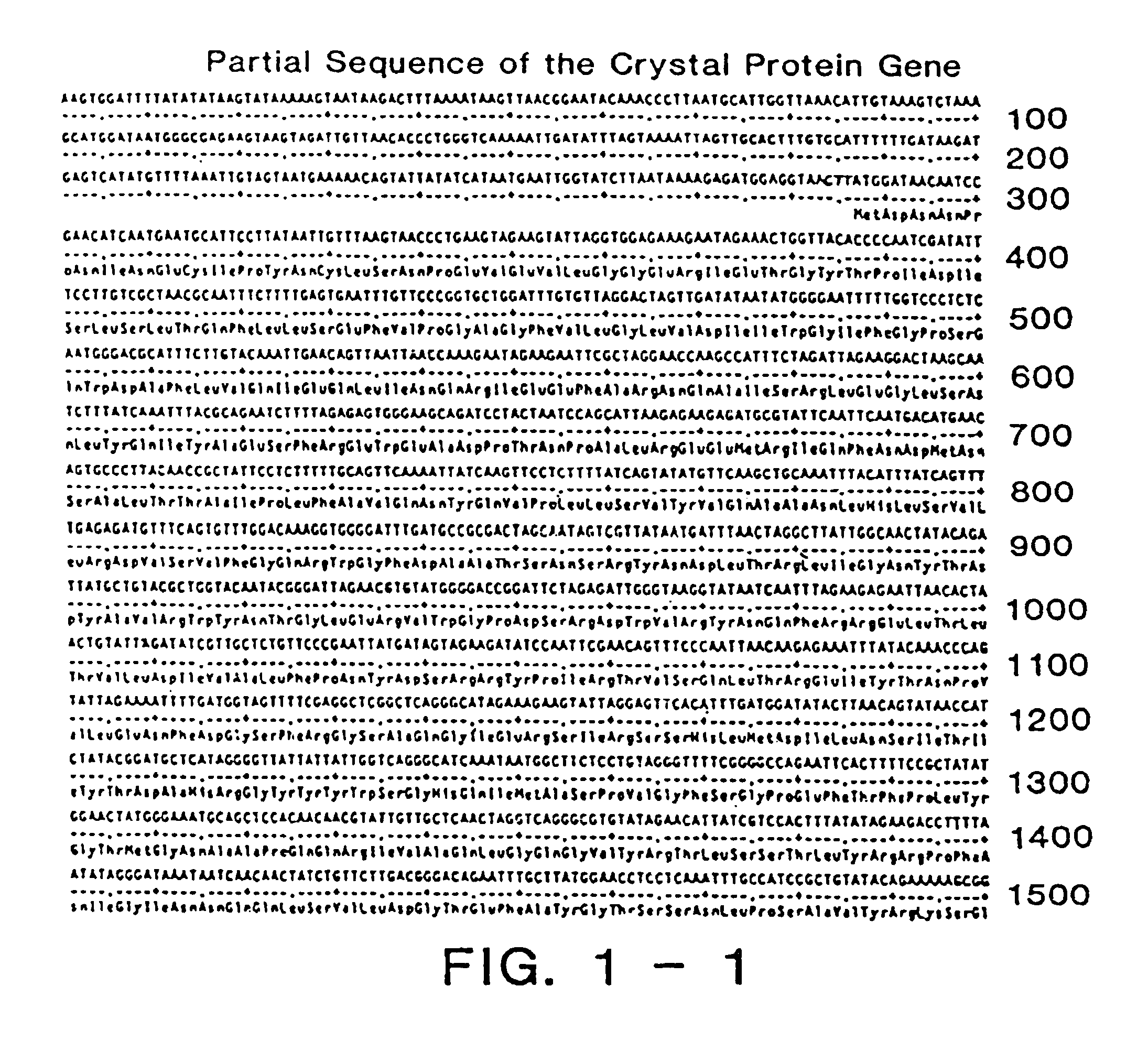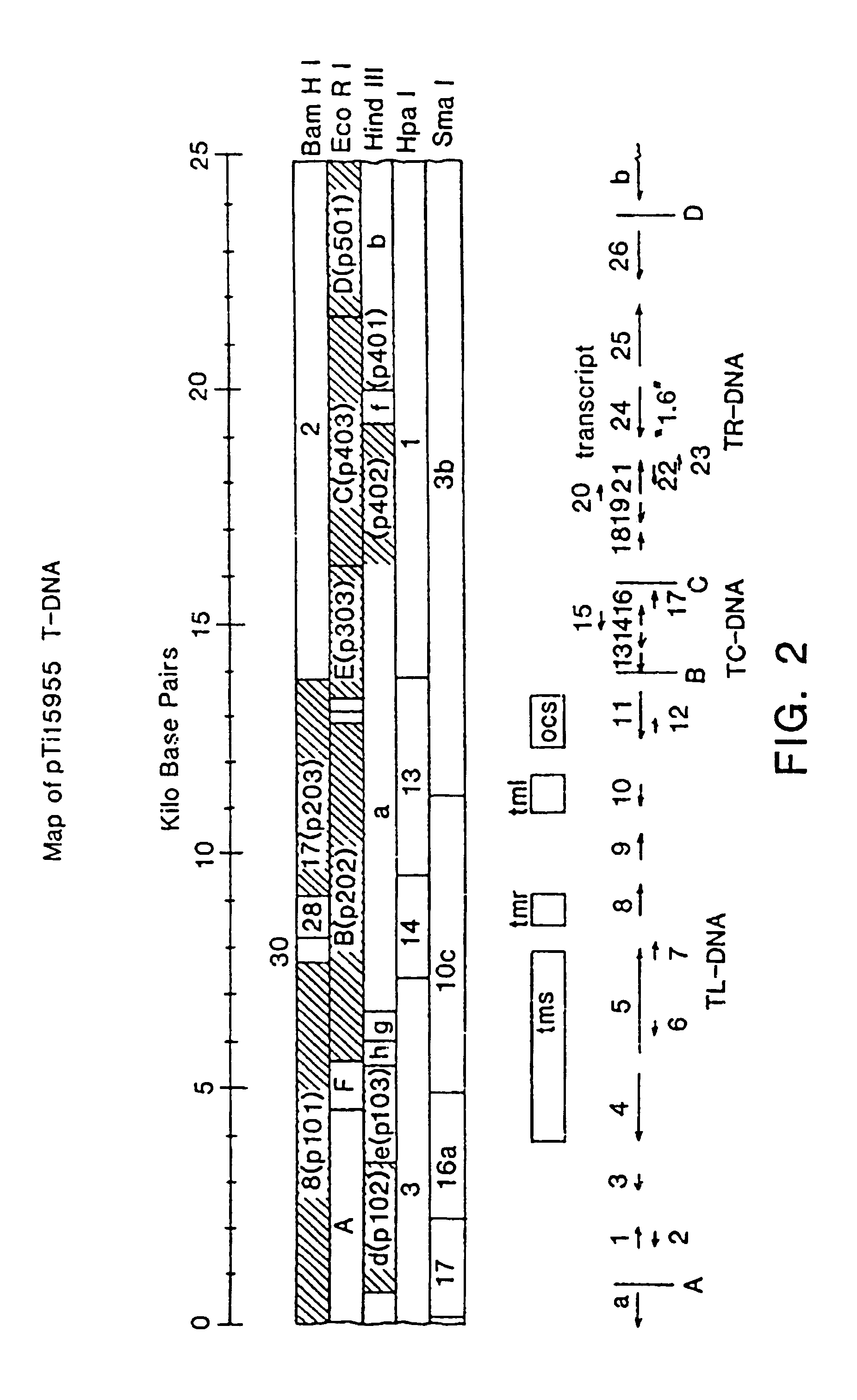Insect resistant plants
a technology of insect resistance and plants, applied in the field of gene engineering, plant husbandry, and bacterial bioaffecting compositions, can solve the problems of toxic leaves of insect larvae, and achieve the effects of eliminating non-uniform application and costs, stably reproducing, and susceptibility to a number of larva
- Summary
- Abstract
- Description
- Claims
- Application Information
AI Technical Summary
Benefits of technology
Problems solved by technology
Method used
Image
Examples
example 1
[0077]The first step in developing an insect resistant crop was to clone the insecticidal protein gene of B. thuringiensis var. kurstaki HD-73, which is on deposit with the Agricultural Research Culture Collection, Northern Regional Research Laboratory, Peoria, Ill, and has NRRL number B-4488.
1.1 Cloning the Bacillus thuringiensis Insecticidal Protein Gene
[0078]The 50 megadalton (MD) plasmid was enriched from HD-73 using sucrose gradient centrifugation. An HD-73 library was constructed by first digesting this plasmid with HindIII. The resulting fragments were mixed with and ligated to HindIII-linearized pBR322 (Bolivar, F. et al. (1978) Gene 2:95-113) and transformed into E. coli HB101. Ampicillin-resistant tetracycline-sensitive transformants were screened by digesting isolated plasmid DNA with HindIII and choosing those clones with 6.6 kilobase pair (kbp) inserts. Colonies containing plasmids p123 / 58-3 and p123 / 58-10 were selected from the HD-73 library for further analysis using ...
example 2
[0083]This example teaches the insertion of the Bacillus thuringiensis insecticide gene between a T-DNA gene promoter and a polyadenylation (poly(A) addition) signal, the transfer of the insecticide gene to various plant species via a Ti plasmid, and the regeneration of plants expressing this gene under control of the T-DNA promoter. A large part of the strategy used in this construction is diagrammed in FIG. 3, which represents plasmids schematically and is not necessarily drawn to scale.
2.1 Introduction of BamHI Site into the Insecticidal Protein Gene
[0084]A BamHI site is introduced into the insecticidal protein gene of p123 / 58-10 at a location just 5′ to the start of the coding sequence. The wild type base sequence (b) and the changed bases in an oligonucleotide primer (a) are as follows:
[0085]
BamHIa)5′AGATGGAG*GATCCTT ATG GAT AAC AAT 3′b)...AGATGGAGGTAACTT / ATG / GAT / AAC / ... Met Asp Asn Asn
The changed bases are the underlined ATC sequence in (a). Note th...
example 3
[0103]This example teaches another method of inserting an expressible gene for the B. thuringiensis insecticidal protein into a plant genome. The shuttle vector is similar to that used by Fink, C. L. (1982) M.S. thesis, University of Wisconsin-Madison, to put the nos gene into an octopine Ti plasmid. In the present invention, the protein coding sequences for nos are removed and replaced with an insecticidal gene before insertion into the Ti plasmid. The eventual result is an octopine-type Ti plasmid carrying an insecticide gene expressible in plant cells under control of a nopaline synthase promoter.
3.1 Moving the Nos Gene into M13mp7
[0104]pCF44 DNA (Fink, supra) was digested with XhaI, religated to itself, and transformed back into K802. Plasmid DNA isolated from ampicillin-resistant transformants was analyzed with restriction enzymes. A plasmid having a single XhoI site within its Ti plasmid-derived DNA sequences was designated pCF44A. The single XhoI site was the result of the de...
PUM
| Property | Measurement | Unit |
|---|---|---|
| Fraction | aaaaa | aaaaa |
| Fraction | aaaaa | aaaaa |
| Fraction | aaaaa | aaaaa |
Abstract
Description
Claims
Application Information
 Login to View More
Login to View More - R&D
- Intellectual Property
- Life Sciences
- Materials
- Tech Scout
- Unparalleled Data Quality
- Higher Quality Content
- 60% Fewer Hallucinations
Browse by: Latest US Patents, China's latest patents, Technical Efficacy Thesaurus, Application Domain, Technology Topic, Popular Technical Reports.
© 2025 PatSnap. All rights reserved.Legal|Privacy policy|Modern Slavery Act Transparency Statement|Sitemap|About US| Contact US: help@patsnap.com



